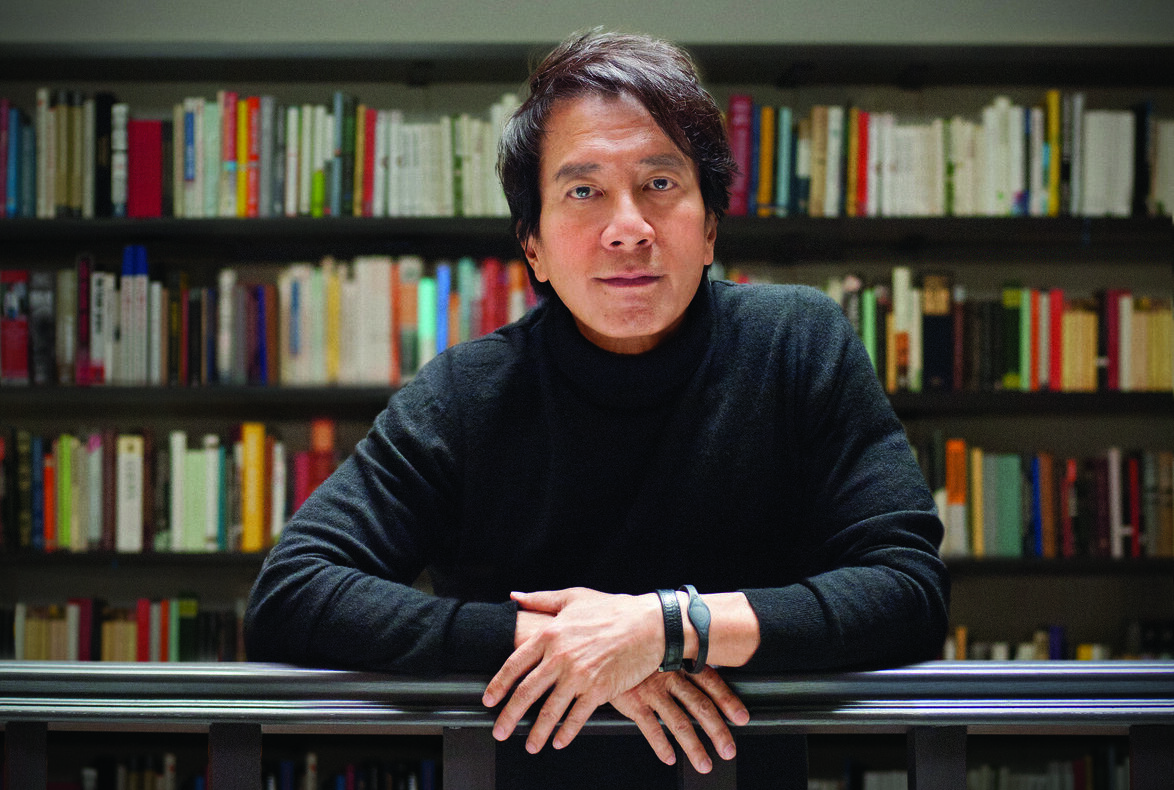* DESIGNER OF
THE YEAR 2009

Tham Khai Meng
Worldwide Creative Director
Ogilvy & Mather, New York
DISCIPLINE
Visual Communication
From an early age, Tham Khai Meng already had a desire to change the status quo to improve his environment. He recalls, “As a child, when my parents were out of the house, I’d reconfigure the furniture. Things just felt right the way I’d arranged it. And when they came home, they’d find that nothing was quite the same.” He remembers his father, “a civil engineer and a painter of not inconsiderable talent”, providing an outlet for that restless creativity by setting aside white walls on which Mr Tham and his brother could write, draw and paint.
These days, Mr Tham is breaking down walls and changing the world with his creativity. In a stellar career that has clinched every important award in the industry and drawn numerous accolades from around the world, Mr Tham is widely recognised as an exceptional creative director and a leader in the field. His current post as Worldwide Creative Director with Ogilvy & Mather, New York, seems to be a natural culmination of what began years ago with white walls at home in Singapore.
Mr Tham sees design as important “because it has become an essential tool for personal happiness and professional success.” He says, “With advancing technology, good design is now more accessible than ever. This allows more people to partake in its pleasure and become connoisseurs of what was once specialised knowledge. Now, from a business and economic point of view, design has become crucial for most modern businesses as a means of differentiation and as a way to create new markets … As design sensibility filters through the consumer marketplace, design will have the opportunity to realise its ultimate purpose: to change the world.”
Good design, in Mr Tham’s view, is simple. “In good design, form follows function. I’m a great believer in that, from a tea cup to a t-shirt, from a house to a city … Good design can be seen when brands use design at the top of their brand thinking. Apple is one of the masters of using great design to sell its products.” He also cites Ty Nant bottled water as an example of good design. “The Ty Nant bottle is designed like flowing water. Manufacturers and material specialists came up with a beautiful bottle at a price lower than glass. They discovered that the ‘flowing water’ design has more tensile strength than that of a conventional plastic bottle so a thinner plastic skin was used and the cost per bottle came down. Good design triumphs!”
Mr Tham’s design outlook rests on the belief that “design allows us to influence the future while we brand the present”. What sets a good design apart is its ability to connect with the aspirations of the audience. Mr Tham explains, “At Ogilvy we have what we call ‘The big ideaL’ … This is our creative approach to connecting brands to larger cultural truths … Now, that is bigger than a big idea. It can transform a company inside and out and it can excite the press and culture more than a pure advertising idea. It gives people the greater sense of purpose that they seek nowadays.” Examples of this approach include such famous Ogilvy & Mather campaigns as Dove’s “Campaign for real beauty”, BP’s “Beyond petroleum”, IBM’s “Smarter planet” and Coke’s “It’s possible”. Says Mr Tham, “We always have the target audience, the consumer, in mind.”
Just as his creativity knows no boundaries, Mr Tham’s inspiration comes from everywhere. He says,
“Inspiration comes from every nook and cranny, from the mundane to the sublime. We need to be open and receptive to everything around us. I think you have to be ready when an idea comes to you. You’ve got to catch that cock-eyed genie by its tail. Creativity is seeing what everyone is seeing but thinking what no one else is thinking. Creative people have an obligation to go down the road less travelled. We can’t help that, I guess. We are made that way.”
Among his influences, he names Mies van der Rohe, Richard Neutra, Moholy-Nagy, Mark Rothko, Man Ray, Dubuffet, Basquiat and Milton Glaser. “And of course,” he adds, “my mentor, Neil French.”
Mr Tham’s passion for world-changing design complements his zeal for technology and innovation, and the possibilities these hold for sustainable development. “I believe that technology and design will deliver us to a Utopian ideal … The world is facing all sorts of problems associated with over-congestion and overpopulation. How can we innovate for a more sustainable planet? The answer lies in the two dominant issues today: the environment and the economy. I believe that one shouldn’t run counter to the other. We should be thinking of smart, innovative ways to fill that counter-intuitive gap. As David Brower of the Sierra Club said, ‘There is no business to be done on a dead planet.’”
To promote sustainable development, Mr Tham is working on a project with the United Nations (UN) to create an awareness of sustainability among world leaders and the public at the upcoming Copenhagen Summit on Climate Change. He elaborates, “We are in the midst of creating what I think is one of the most powerful and innovative campaigns of all time with the bold ambition of changing the world. It is based on creating a global movement asking the people of the world to engage with their leaders to drive climate change at the upcoming UN Climate Change Conference this December in Copenhagen. The idea we thought up is to change the reference from “Copenhagen” to “Hopenhagen,” making the conference stand for something we all want – hope for a better world. The campaign is built on using social media to connect people with their leaders. We believe that if people lead, the leaders will follow. It’s a global movement spread through social media with local participation and activism. It’s an idea whose time has come.”
In Singapore, Mr Tham has served on a number of boards, including Prime Minister Lee Hsien Loong’s Economic Review Committee in 2002, a think tank of business, academic and government leaders tasked with finding a strategic direction for the country in its evolution from a manufacturing to a knowledge-based economy. Mr Tham observes, “The Singapore Government understands how crucial a role design can play in the future and prosperity of the nation state. Singapore wants to move up the value chain in the knowledge economy and be a world design hub. They are investing in the creative industry which covers advertising, product design, graphic design, architecture, city planning, animation, automobile design, film-making, even three-dimensional filmmaking, etc. Singapore is using design as a magnet to attract talent, corporations, educational institutions and direct capital investments. This is a significant move and bodes well not only for the country but for Asia. For a small country, Singapore is punching way above its weight.”
Mr Tham acknowledges that he works in a demanding industry, and that high and low points are to be expected. “The lows for anyone in this toughest of businesses are when your work does not get sold. The highs are when you are able to do work that makes a difference.” He attributes his success to his passion for his work and his drive for excellence. “I greatly enjoy what I do every day. I’m very fortunate in that sense. I guess I have an intolerable disdain for mediocrity. Mediocrity – what a waste of time that is!”
Mr Tham is a believer in mentoring the young. He says, “Our youth represent the future of our organisations, our countries and our economies. We all have a role to play in giving back to the next generation.” He describes the process of talent-spotting at Ogilvy & Mather when he was still based in Asia: “Quite often we’d pluck the young rising stars out of their office’s cocoons. We give them a glimpse of the real world, give them real competition, fast track them and see how they fare. Some stayed the course, some didn’t make it and some excelled. You have to understand that this business is one of the hardest gigs to thrive in … The ones with any real potential are the ones who are hardworking, tenacious and passionate.” In particular, he finds it fulfilling and “tremendous fun coaching talent to discover their inner greatness”. Says Mr Tham, “I try to find the time at every opportune time to teach. I learnt at the feet of David Ogilvy, who taught us that ‘To lead, you have to teach.’”
For Mr Tham, being conferred the President’s Design Award is a great honour. He says, “I owe this to everyone I have worked with and who has helped me.”
READ MOREInsights from the Recipient
Citation
Jury Citation
As the first worldwide Asian creative director of any Western international holding company, Tham Khai Meng has now been charged with the role of turning Ogilvy into a worldwide creative powerhouse in the same way that he turned Ogilvy in Asia into a regional creative tiger.
One of his recent projects includes the United Nations’ movement “Hopenhagen”, which signifies a moment and a chance at a new beginning. The hope that we can create a global community that will lead our leaders into making the right decisions. The hope that we can solve the two greatest problems of our time – the economy and our environment. This movement is expected to culminate at the UN Climate Change Conference to be held in Copenhagen on 7 December 2009.
Khai Meng is recognised for being a world star who does an enormous amount for raising the profile of Singapore as a centre of creative thinking and his position as a global figure, thus making him a lodestar for young talents across the region.
The Jury unanimously agrees that Khai Meng is an international giant, inspiring an entire generation of creatives around the world. His remarkable talent has and will continue to shape, change and improve the way we all live.
VIEW JURORSNominator Citation
MS JANE FRASER
REGIONAL DIRECTOR CORPORATE COMMUNICATIONS
OGILVY & MATHER ASIA PACIFIC
One of the world’s most respected and awarded creative directors, Singapore’s Tham Khai Meng has played an integral role in turning the creative compass towards Asia and Singapore. As Ogilvy’s Worldwide Creative Director, Khai oversees the creative output of 450 offices scattered across 120 countries with a business revenue of US$2 billion.
Ogilvy, the third largest marketing communications agency in the world, would not be the creative force it is today without its Asian operation. Ogilvy Asia-Pacific contributes a staggering 52 per cent of Ogilvy’s network awards tally, according to the Gunn Report. The network’s success, consistently achieved for almost a decade, has seen Khai named Creative Director of the Year consecutively since 2001, according to Campaign Brief Asia. The emphasis on creativity has helped the Asia-Pacific network become a US$500 million business.
According to the New York-based publication Advertising Age, Khai is “One of the world’s most influential people in the communications business”. Khai has also been named Regional Head of the Year by Media magazine.
He has chaired and served on all five of the industry’s top international award show juries. They include Cannes, The One Show, D&AD, Clios and the London International Advertising Awards.
In November 2008, Ogilvy & Mather Worldwide identified and selected Khai from the Asia-Pacific network to spearhead and run their global operations from New York as Ogilvy’s Worldwide Creative Director. Khai is the first Asian ever to hold this position in any global agency network. The appointment further demonstrates – like the global economy – how the industry’s centre of balance is shifting eastwards.
Khai’s ongoing success in Asia earned him global recognition long before he was awarded the worldwide role in New York. In 2005, Khai became the first Asian to chair the Clios judging panel. In 2007, Ogilvy Singapore, the Asian network’s flagship creative agency, was the third most-awarded agency in the world at Cannes.
Educated at the Anglo-Chinese School in Singapore, Central Saint Martins University of the Arts, London and Royal College of Art, London, Khai’s career includes stints in London, Chicago and across Asia.
Khai has served on several boards, including Singapore Prime Minister Lee Hsien Loong’s Economic Development Committee, a think tank of business, academic and government leaders that was tasked with finding a strategic direction for the country, which was migrating from a manufacturing to a knowledge-based economy.
Khai also served on three Temasek group companies between 2003 and 2005. He was Deputy Chairman of DesignSingapore Council between 2003 and 2006; served on the National Arts Council Board between 2002 and 2004; and the Urban Redevelopment Authority Board between 2007 and 2009.
Khai is the author of The Ugly Duckling – A Cautionary Tale of Creativity, now translated into Korean, Japanese and Mandarin. In 2006, the Berlin School of Creative Leadership elected Khai to be a member of the teaching faculty of their Executive MBA programme at Steinbeis University, Berlin.
Khai is now working on a project with UN Secretary-General Ban Ki-moon to bring sustainability, a major issue, to the public and to the world leaders’ awareness.
Khai lives in Manhattan, New York, with his family.










